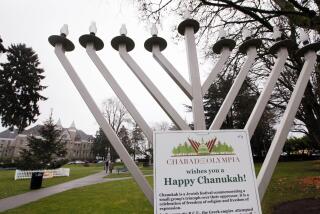WEST HILLS : Crafting New Involvement in Old Tradition
- Share via
Barbara Cavaleri stitches tiny golden beads not much bigger than grains of sand onto a piece of Italian wool cloth. By October, the West Hills mother will be finished with the prayer shawl or tallit (pronounced ta leet ) that she’s making for her son to wear at his bar mitzvah.
Cavaleri and four others will spend each Wednesday night learning to make tallitot (the plural of tallit) in a six-week class at the West Valley Jewish Community Center in West Hills.
For the record:
12:00 a.m. May 1, 1994 For the Record
Los Angeles Times Sunday May 1, 1994 Valley Edition Metro Part B Page 2 Column 1 Metro Desk 2 inches; 36 words Type of Material: Correction
Prayer shawls--A story in Saturday’s Times about classes in the art of making Jewish prayer shawls, or tallitot , omitted the name of the teacher of the courses held at the West Valley Jewish Community Center in West Hills. The teacher is Helene Gordon.
Instead of purchasing tallitot from temple gift shops in this country or in Israel, a growing number of women are making the sacred garments for their children’s bar mitzvah and bat mitzvah ceremonies.
“This is a way of expressing (myself) to him and (is) something very special and beautiful to give to a child,” Cavaleri said. “You can store-buy these, but when you make it yourself, you’re passing something to them in a tradition that’s gone on for centuries.”
During the two-hour class, the women trim and measure their fabric and adorn it with ribbon, beads and thread.
Tobie Treitman, 64, suffered a brain aneurysm two years ago and balked when her 12-year-old granddaughter asked her to make a tallit.
“I said, ‘I’ve had a stroke, I can’t, Melissa,’ and she said, ‘yes, you can,’ ” Treitman said.
“When she said yes I can, I figured I could.”
Jewish law requires Jews to wear tallitot whenever they pray, publicly or privately, once they turn 13. The tallit represents God’s commandments to Jews, and wearing the sacred garment is a reminder to follow the commandments.
The collar portion of the tallit can contain a prayer stitched in Hebrew.
Though the prayer is optional, tzitzit--pieces of string which symbolize the 613 commandments of the Torah--are not. Tzitzit hang from the four corners on each tallit and give the garment its significance. Tallit makers follow strict laws outlining how the string is wound and knotted.
Tallit-making teachers such as Bonnie Vorspan of Woodland Hills have helped transform the tallit into a garment that, although sacred, expresses an individual’s personality.
Lee Pasternak of Ventura County wouldn’t have it any other way. Pasternak and her sister, Cheryl Kaplan, are teaming up to make tallitot for Pasternak’s son and daughter.
The children, now 9 1/2 and 11, will have their bat mitzvah and bar mitzvah ceremony together. Pasternak remembers the tallit she wore during her bat mitzvah, and she wanted something different for her children. So did her daughter.
“My daughter told me mine was very ugly,” Pasternak said. “She said, ‘I don’t care what you do as long as it’s pink and flowers,’ but that’s nice because that’s her. That’s her personality.”
Vorspan taught five classes last year and at least four other Valley-area residents teach tallit-making, but it is estimated that no more than 10% of Jews hand make tallitot.
For some, tallit-making is more than a chance to be expressive, it’s also a way to involve the family in an important ceremony.
Debbie Caminker, 39, has given herself two years to make a tallit for her daughter Rachel, now 11.
Rachel and her mom have gone to sewing and fabric stores together, picked out the ribbon together and shared ideas on how to make the tallit.
“My class night has become very important to me and everybody in the family is pitching in to help me get there,” Caminker said.






